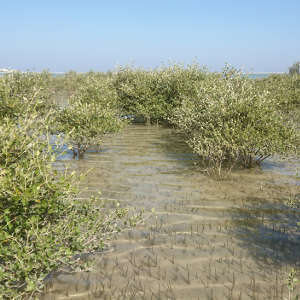Using AI to control energy for indoor agriculture
30 September 2024
Published online 22 January 2021
Shifting atmospheric conditions contributed to the desertification of mangrove ecosystems along the Omani coast.

Valeska Decker/University of Bonn
Millennia ago, this region was verdant and hospitable. “Sedimentological and geochemical evidence show nice, mangrove-fringed lagoons that were seasonally inhabited by humans,” says Decker. But at some point in the past 6,000 years, this territory essentially became a desert.
The reasons for this transformation are unclear, and Decker set out to resolve this mystery as part of her doctoral research, with advisor Gösta Hoffmann. They focused on three factors that could have had an impact of this magnitude on the coastal ecosystem: shifting sea levels, human influence, and climatological shifts.
Mangroves are home to plants that thrive in brackish coastal water, but can be killed off by sea level shifts that radically alter soil salinity. The researchers ruled out this possibility after precisely measuring the spatial distribution of the geological remnants of those ancient mangroves. Their findings showed that these layers existed within the historic intertidal range of this coastal region, and that these tidal peaks had not changed markedly in 7,000 years.
Although hunter-gatherer populations routinely visited the mangroves throughout this period, an investigation of the archaeological data indicated their presence was not immensely disruptive. “They used the mangrove ecosystems for food supply and wood for cooking,” says Decker. “This probably put additional pressure on these ecosystems, but didn’t kill them.”
Instead, their investigation implicated the climatic consequences of movement in an atmospheric region known as the intertropical convergence zone (ITCZ). This is a relatively windless low-pressure system encircling the Earth near the Equator. Several studies have suggested that the ITCZ underwent a notable southward shift around the same timeframe as the collapse of Oman’s coastal mangroves. This shift would have produced a dramatic reduction in rainfall over time, and Decker postulates that this aridification eventually crossed a threshold that could no longer support the survival of this ecosystem.
She notes that this is still a hypothesis. “Some researchers deny that the ITCZ has shifted at all,” says Decker. Accordingly, she and her colleagues are now extending their investigation to surrounding areas of the Omani coast to further validate their findings, and to reconstruct a more detailed history of these coastal ecosystems.
doi:10.1038/nmiddleeast.2021.6
Decker, V. et al. Collapse of Holocene mangrove ecosystems along the coastline of Oman. Quat. Res. Rev. https://doi.org/10.1017/qua.2020.96 (2020).
Stay connected: